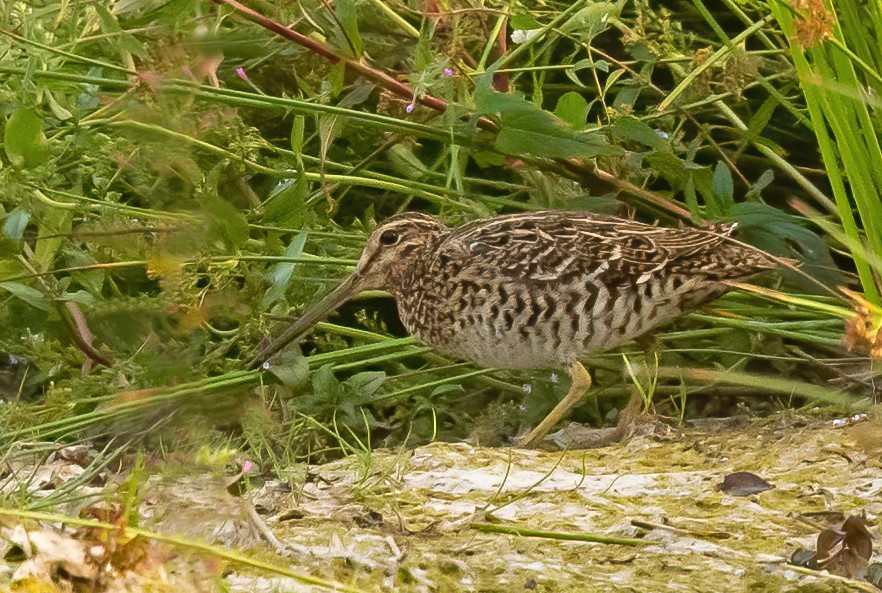Poelsnip
Gallinago media · Great Snipe
 Poelsnip ·
Gallinago media
·
18-06-2022 · Eduard Sangster
Poelsnip ·
Gallinago media
·
18-06-2022 · Eduard Sangster
| Datum | 18 June 2022 |
|---|---|
| Locatie | Hardenberg |
| Fotograaf |
|
| Bekeken | 3909 × |
De Poelsnip is (nog) een beoordeelsoort in Nederland. De meeste Poelsnippen uit noord/oost Europa vliegen in 1 ruk door naar Afrika, vandaar dat wij ze relatief weinig zien in Nederland. Deze maakte gelukkig wel even een pitstop. Fijne ontdekking van Julian Overweg, dank je wel! |
Discussie
Max Berlijn
·
19 June 2022 14:41
ai ai, weer "afgeEduut". Best een rare tijd voor de soort, zou het een failed breeder zijn al op weg naar diens overwintering??
Johan van 't Bosch
·
19 June 2022 14:59
Op de foto's vind ik de snavel langer lijken dan ik in mijn hoofd heb bij een Poelsnip. Kan dat een indicatie van geslacht zijn? Ik denk dan richting vrouw. Ik heb geen literatuur erop nageslagen, puur een gedachte die bovenkwam.
Eduard Sangster
·
19 June 2022 16:38
@ Johan, ik lees dit in BOW: Female very similar to male, but averages slightly larger.
@Max, dank je wel 😉 Als ik onderstaande lees in BOW, dan heb je gelijk dat dit een rare tijd is. Een failed breeder uit Scandinavie, of een héle late doortrekker uit Oost-Europa?
Departure from breeding grounds from early Aug. Three birds marked with geolocators in Sweden that spent the winter in tropical Africa made long and fast non-stop flights (4300–6800 km in 48–96 hours) not only over deserts and seas but also over wide areas of suitable habitat. From a total of 19 Swedish males tracked by light-level geolocators in four different years, about half of them made stopovers in N Europe in early autumn, leaving the breeding area 15 days earlier than those which flew directly to sub-Sahara; the autumn trans-Sahara flights were on average 5500 km long, lasted 64 h, and were flown at ground speeds of 90 km/h; the arrival in the Sahel zone coincided with the wet season there, and the birds stayed for on average three weeks. The birds arrived at their wintering grounds around the lower stretches of the Congo River in late Sept and stayed for seven months. In spring the birds made trans-Sahara flights of similar length and speed as in autumn, but the remaining migration through E Europe was notably slow; all birds returned to the breeding grounds within one week around mid-May.
Northward migration occurs in broad front over Africa Mar–Apr (last record in Zambia second week of May), and probably oriented more to W (as few records in Ethiopia in spring), crossing Mediterranean, but northbound migration passes largely unnoticed; males arrive in Ukraine before females; arrives on R Yenisey in early Jun.
Peter de Knijff
·
19 June 2022 17:18
Geeft BOW geen basale biometrie?
Cramp geeft snavel voor man (n=26, alle leeftijden) 61.2 (min-max 54-69). Voor vrouw (n=19) 64,7 (58-69).
Glutz geeft iets meer data, maar feitelijk dezelfde gemiddelden en spreiding.
Deze verschillen zijn significant, maar lijken mij in het veld niet waarneembaar.
Johan van 't Bosch
·
19 June 2022 21:58
Julian Overweg
·
20 June 2022 15:25
Graag gedaan Eduard! Fijn dat de vogel vrijwel de hele dag goed te zien bleef. Jouw foto hoort bij de mooisten! 👌
Peter Adriaens
·
20 June 2022 20:11, gewijzigd 20 June 2022 20:11
In Armenië (dus ver ten zuiden van de broedgebieden) was er nog doortrek einde mei - begin juni:
https://observation.org/observation/133601163/
https://observation.org/observation/134033261/
https://observation.org/observation/134033262/
Gebruikers van het forum gaan akkoord met de forumregels.
